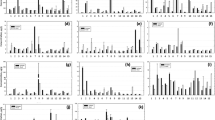Abstract
The carp ponds of Deroua station (Beni Mellal, Centre of Morocco) receive a large quantity of fertilizers, particularly urea and triple super phosphate during the entire period of culture. Only a small part of that is necessary to promote an adequate development of phytoplankton, the base of the food chain. A large part of the phosphate added to the ponds is stocked in pond soils and can be released under specific conditions. Although some phosphate is necessary for the development of aquatic populations, too large of an input causes problems. Therefore, knowledge of the external load and the mobility of the internal pool is essential for the purpose of management against eutrophication. In order to assess the inorganic and organic fractions of phosphate present in sediments, different methods of P fractionation were compared. The methods do not give the same results. In the Deroua sediments, calcium-bound phosphate represents the major part of total phosphate between 86% and 91% according to the different methods. The org-Phosphate represents a small part and varies considerably depending on the different methods between 0.87 and 5%. EDTA extractions (Golterman, 1996) have an advantage over other methods such as the Sedex, the Hieltjes &; Lijklema and the Bonzongo procedures.
Similar content being viewed by others
References
Aspila, K. I., H. Agemian &; A. S. Y. Chau, 1976. A semi-automatic method for the determination of inorganic, organic and total phosphate in sediments. Analyst 101: 187–197.
Bonzongo, J. C., G. Bertru &; G.Martin, 1989. Speciation phosphorus techniques in the sediments: discussion and propositions to evaluate inorganic and organic phosphorus. Arch. Hydrobiol. 116: 61–69.
Boström, B., M. Jansson &; C. Forsberg, 1982. Phosphorus release from sediments. Arch. Hydrobiol. Beih. Ergebn. Limnol. 18: 5–59.
De Groot, C. J., 1990. Some remarks on the presence of organic phosphate in the sediment. In Bonin, D. J. &; H. L. Golterman (eds), Fluxes Between Trophic Levels and Through the Water-Sediment Interface. Developments in Hydrobiology 62. Kluwer Academic Publishers, Dordrecht, The Netherlands: 303–311. Reprinted from Hydrobiologia 207.
De Groot, C. J. &; H. L. Golterman, 1990. Sequential fractionation of sediment phosphate. Hydrobiologia 192: 143–149.
De Groot, C. J. &; H. L. Golterman, 1993. On the presence of organic phosphate in some camargue sediments: evidence for the importance of phytate. Hydrobiologia: 252: 117–126.
Fabre, A., A. Qotbi, A. Dauta &; V. Baldy, 1996. Relation between algal available phosphate in the sediments of the River Garonne and chemically-determined phosphate fractions. Hydrobiologia 335: 43–48.
Golterman, H. L., R. S. Clymo &; M. A. M. Ohnstad, 1978. Methods for Physical and Chemical Analysis of Freshwaters, IBP Manual No. 8 (2nd edn). Blackwell Scientific Publications, Oxford: 213 pp.
Golterman, H. L. &; A. Booman, 1988. Sequential extraction of ironphosphate and calcium-phosphate from sediments by chelatings agents. Verh. int. Ver. Limnol. 23: 904–909.
Golterman, H. L., 1995. The role of the ironhydroxide-phosphate sulphide system in the phosphate exchange between sediments and overlying water. Hydrobiologia 297: 43–54.
Golterman, H. L., 1996. Fractionation of sediment phosphate with chelating compounds: a simplification, and comparison with other methods sediment. In Golterman, H. L. (ed.), Sediment-Water Interaction 6. Hydrobiologia 335: 87–95.
Golterman, H. L., J. Paing, L. Serrano &; E. Gomez 1998. Presence of and phosphate release from polyphosphates or phytate phosphate in lake sediments. In Golterman, H. L. (ed.), Sediment-Water Interaction 8. Hydrobiologia 364: 99–104.
Hieltjes, A., H. M. &; L. Lijklema, 1980. Fractionation of inorganic phosphates in calcareous sediments. J. Envir. Qual. 9: 405–407.
Lucotte, M. &; D'Anglejan, 1985. A comparison of several methods for the determination of iron hydroxides and associated orthophosphates in estaurine particulate matter. Chem. Geol. 48: 257–264.
Mesnage, V. &; B. Picot, 1993. Comparison of two methods for the fractionation of the sediment bound phosphate: estimation of phosphate fractions mobility. Journal Français d'Hydrologie 24: 55–68.
Ruttenberg, K. C., 1992. Development of a sequential extraction method for different forms of phosphorus in marine sediments. Limnol. Oceanogr. 37: 1460–1482.
Tessier, A., P. G. C. Campbell &; M. Bisson, 1979. Sequential extaction procedure for the speciation of particulate trace metals. Anal. Chem. 51: 844–851.
Author information
Authors and Affiliations
Rights and permissions
About this article
Cite this article
Kassila, J., Hasnaoui, M. & Yahyaoui, A. Sequential extractions of inorganic and org-Phosphate from fish pond sediments (Deroua station, Beni Mellal, Morocco) by different fractionation methods. Hydrobiologia 431, 51–58 (2000). https://doi.org/10.1023/A:1004002321425
Issue Date:
DOI: https://doi.org/10.1023/A:1004002321425




